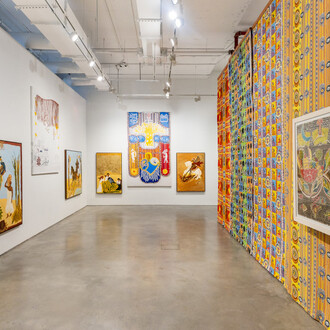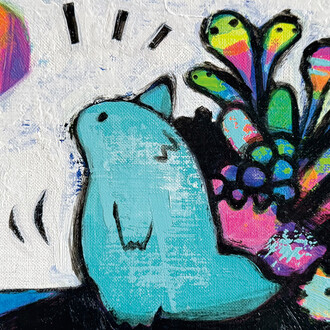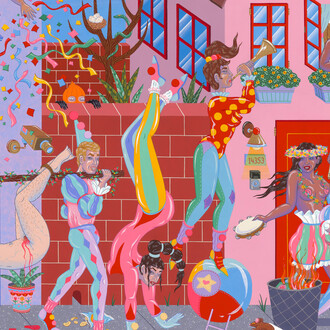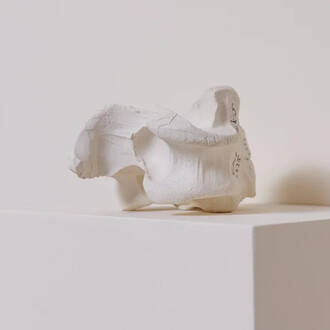Nara Roesler New York is pleased to present Exploded view, André Griffo’s first solo show in the United States. With a critical essay by Lúcia Stumpf, the show brings together around 12 works by the artist developed over the last year specifically the exhibition.
With a background in Architecture, André Griffo considers the representation of elaborate architectural spaces to be an integral part of his poetics. “The main theme of my research is religion”, says the artist, who through his work seeks to reflect on how religion has been used as a tool for control and domination throughout history. Griffo uses religious architecture to examine the historical relationship between the presence and power of the church from Brazil’s colonial past to the present day, where neo-Pentecostal pastors use religion to influence politics, while simultaneously being linked to paramilitary groups.
The exhibition title refers to the technical drawing of the same name, which consists of a diagram showing a relationship or sequence of assembly of various parts in a set. This concept is present in the exhibition through a sequence of five works created by the artist; Farm management instructions X, part of the eponymous series of paintings, represents the interior space of an old church, with an altar in the center, paintings on the ceiling, and a series of ornamental elements that emphasize the sacred figure located on the altar. In the artist’s words: “the sacredness of this type of figure lies not only in itself, but in all the ornaments that highlight it. Their importance is so great that they often stand out more than the figure itself, and can even play their part”.
The main painting, however, does not only feature sacred elements but is located within a larger space, possibly a large farm. There are no human representations on a scale proportional to the space, except for a portrait on the wall of a man, possibly the owner of the place. On the floor, however, miniature figures are scattered about, reminiscent of slaves working tirelessly. In addition to the play on scales between space and characters, the room is composed of several plants historically used by the enslaved people in religious rituals. These elements refer to the fact that having been enslaved, forcibly removed from their homeland, and cut off from their customs, they could not exercise their faith freely notably having objects and icons confiscated. As a result, slaves had to adapt aspects of their original beliefs to their reality in Brazil, and began to use local plants as proxies, using them as a means of representing their deities.
From this large painting, Griffo produced a series of other related works, consisting of fragments of the original composition that the artist ended up highlighting and representing individually. While the original canvas depicts the entire architectural space, in the following works the artist focuses on the details of the original composition, such as the apse, the altar, and the image of the Saint himself.
References to art history in a broader sense are present in other works in the show, such as Constantino’s sleep and Constantino’s dream. The titles refer to a 15th-century fresco by Piero della Francesca, in which the painter recounts the conversion of the Roman Emperor Constantine to Catholicism. This is said to have happened through a dream, in which the ruler saw a cross carried by an angel. Touched by the image, he went into a decisive battle carrying the object and, victorious, embracing the new faith once and for all. According to Griffo, however: “This version of Constantine’s conversion was discarded in the Middle Ages. Possibly even Piero, when he painted it, no longer believed the story, which ended up becoming a legend. It turned out that this conversion occurred much more out of political expediency, which draws parallels with the present day, where many political leaders use fables and fantasies to justify mixing religion and politics to gain supporters”. While in The sleep of Constantine André Griffo rereads the panel painted by the Renaissance master, in The dream of Constantine the artist tries to imagine what the Roman Emperor would have dreamt of. Based on Piero’s composition, Griffo created an abstract painting of enigmatic patches of color, the first abstract painting of his career. Although abstract, it is intensely related to the other canvas, since he used the same chromatic palette as the others and echoes its horizon line.
The dialog between the two –and the three-dimensional also appears in the painting from the series The miniature salesman, which depicts the interior of a subway station, where a salesman presents a series of small miniature dolls laid out in front of him. These dolls consist of figures such as evangelical pastors, policemen, and militiamen executing innocent people, sacred images, and other societal players responsible for sparking and maintaining violence, notably in Rio de Janeiro. In Miniatures, the artist creates 80 plastic figurines that correspond to those represented in the painting. While some are hanging, others are arranged under a tarp, as if they were for sale.
The show also features a rare personal, or biographical work. 80’s, made during Griffo’s residency at the Wassaic Project in New York, depicts the artist’s brother inside the bathroom of the LGBT Center in New York –a space marked by a wall work by the artist Keith Haring made in 1989– which refers to the moment of deep anguish experienced by the LGBT community in the world, due to the AIDS epidemic, and consequently its stigmatization throughout the 1980s. Haring’s painting coincides with when the artist’s brother left his hometown of Barra Mansa and migrated to the United States to be able to live his sexuality freely. When he visited the place, Griffo immediately remembered his brother, who had directly experienced this moment and survived the repression of society and the condition of an immigrant.
Conceiving architecture as an element conceived to shelter social relations, as well as painting as an illusionist tool, Griffo crosses these two medias not as a mere formal exercise, but as a way of tracing social structures and the problems arising from them, bringing in both historical elements and seemingly harmless everyday facts.
André Griffo’s (b. 1979, Barra Mansa, Brazil) practice focuses on painting and its historical relationships with architectural representation. Rather than engaging in grand activist discourses, Griffo invites the viewer to pay attention to the minute details of his images, which depict the many violences that have given shape to the narratives relating to the history of Brazil and its ruins. In this sense, his canvases are complex visual archives in which the most diverse elements coexist, forming relationships that reframe and deepen the criticisms they present. Griffo’s work deals with the critique of power structures, particularly the falsehoods they create to maintain control over individuals. Among these, the artist discusses the lingering effects of the economy of slavery on the historical formation of Brazil and the various mechanisms commonly used by religious institutions to subjugate their followers.
Griffo uses his background in architecture to create spaces where references to both historical and contemporary settings coexist. These spaces, usually deserted, are inhabited by traces, symbols, and signs, that highlight the permanence and influence of the past in current sociocultural issues. His production intertwines the factual and the fictional, exploring connections between the History of Art and Architecture and social issues, both Brazilian and international. By overlapping different temporalities and their complex realities, Griffo’s work denounces constitutive elements of society, and testifies to the immutability of things.
André Griffo lives and works in Rio de Janeiro, Brazil. Recent solo exhibitions include: Voarei com as asas que os urubus me deram, at Nara Roesler (2022), in São Paulo, Brazil; Objetos sobre arquitetura gasta, at Centro Cultural São Paulo (CCSP) (2017), in São Paulo, Brazil; Intervenções pendentes em estruturas mistas, at Palácio das Artes (2015), in Belo Horizonte, Brazil; Predileção pela alegoria, at Galeria Athena (2015), in Rio de Janeiro, Brazil. Main group shows are: Sobre os ombros de gigantes, at Nara Roesler (2021), in São Paulo, Brazil; 21a Bienal de Arte Contemporânea SESC VídeoBrasil (2019), in São Paulo, Brazil; Intervenções, at Museu da República (2016), in Rio de Janeiro, Brazil; ao amor do público, at Museu de Arte do Rio (MAR) (2015), in Rio de Janeiro, Brazil; Aparições, at Caixa Cultural (2015), in Rio de Janeiro, Brazil; Instabilidade estável, at Paço das Artes (2013), in São Paulo, Brazil. His works are including in important institutional collections, such as: Denver Art Museum, Denver, USA; Instituto Itaú Cultural, São Paulo, Brazil; Instituto PIPA, Rio de Janeiro, Brazil; Museu de Arte do Rio (MAR), Rio de Janeiro, Brazil.
















